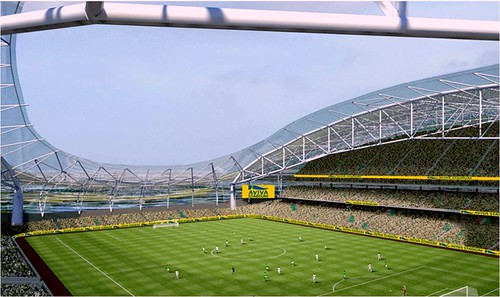Dublin gets spectacular green stadium

Posted June 3, 2010 at 1:36PM
Aviva Stadium, Dublin’s spectacular new sports venue, is as green as it is beautiful.
It’s somewhat rare, if not unprecedented, for me to profile a single building. This one caught my eye because of its stunning architecture, its terrific location in the Irish capital, and its connection to sports. It is also immensely attentive to environmental concerns. This is no ordinary building.
First, as always, let’s start with the location. Aviva is built in the heart of the city, on the 16-acre site of the old Landsdowne Road Stadium, the oldest international rugby ground in the world. Construction was limited to the footprint of the old facility, within the existing city fabric, not apart from it as is the case with so many sports facilities, especially in the US. Indeed, the building’s design exhibits sensitivity to nearby residential streets by tapering the height of the structure to be at its lowest when it is closest to residences.
The stadium is only a mile from St. Stephen’s Green in the center of Dublin, and many patrons will be able to walk, the first method of arrival suggested on the facility’s web site. Others will likely choose DART, the city’s light rail line (with a new concourse from the station to the stadium), or one of four bus lines to the facility. DART also links to Dublin’s tram (streetcar) system.
 Note its position on the Google Earth satellite image above, taken in late 2008 when the site was beginning construction. Notice how the stadium is not surrounded by surface parking lots, as is the case with so many in the US. (Compare, for example, the 200-acre site of FedEx Field, outside Washington, DC, in the smaller satellite image at right.) Although there is limited parking at Aviva, it does not dominate the site or disconnect the facility from its neighbors. Instead, the building further connects psychologically to its surroundings by its architectural transparency. And likewise to the sky, since the covered seating in a land famous for rain is sheltered by a transparent roof.
Note its position on the Google Earth satellite image above, taken in late 2008 when the site was beginning construction. Notice how the stadium is not surrounded by surface parking lots, as is the case with so many in the US. (Compare, for example, the 200-acre site of FedEx Field, outside Washington, DC, in the smaller satellite image at right.) Although there is limited parking at Aviva, it does not dominate the site or disconnect the facility from its neighbors. Instead, the building further connects psychologically to its surroundings by its architectural transparency. And likewise to the sky, since the covered seating in a land famous for rain is sheltered by a transparent roof.
The web site summarizes Aviva Stadium’s impressive green features:
“Managing impacts and the overall sustainability of operations is not a standalone task, but is a standard element of what is done and how it is done. This ensures input, commitment and consistency from the whole team as well as suppliers, service providers and other key stakeholders.
“The stadium redevelopment has been influenced as a result of this, with elements such as onsite crushing of the old stands for reuse as foundation material, recycling of steel rebar from the old stadium, the use of low CO2 concrete in construction and the installation of an artificial otter holt as well as bird and bat boxes along the Dodder river, among some of the initiatives used. Additional design elements include:
- Rainwater harvesting – positioned on the east stand with a 320,000 litre capacity
- Heat recovery (from the diesel generators) – Pipe work from the cooling circuit on the generators ‘absorbs’ the heat produced by the generator for use in heating the water supply for bathrooms, kitchens [and] the under-pitch heating system.
- Waterless urinals - with approximately 400 urinal spaces, on one event day alone there is a saving in excess of 20,000litres of water.
- Energy and water meters - Metering to monitor and manage consumption.
- Acoustic paneling - All plant and equipment specified to not exceed 53 decibels at 1 meter away from the façade
(this is equivalent to the noise emitted by an office laser printer).
“As well as the inbuilt design elements of the stadium, Aviva Stadium has undertaken several other sustainable operational initiatives:
- Promotion of public transport – Active ongoing engagement with all stakeholders to promote non car modes of transport to and from the stadium.
- Waste management strategy – Aviva Stadium promotes a reduction in waste generation as its primary focus and then the segregation and diversion from landfill for any waste generated as a secondary focus supported by compostable food packaging where possible.
- Promoting local produce – All dairy and protein food items sold or prepared at the stadium are nationally sourced.
- Community Fund - €100,000 Annual Community Fund available to support local activities and ventures.
- European Healthy Stadia Network – Aviva Stadium has applied to participate in the European Healthy Stadia Initiative, a venture that engages in Health Promotion for employees, spectators and other stakeholders.
The new stadium will seat 50,000 rabid fans of rugby, soccer, Gaelic football and, I suspect, many other events. Work began in May 2007, employing over 6,000 people in one capacity or another; at peak construction, just over 1,300 workers were on site on a daily basis. Among the many amenities, “the ‘state of the art’ beer systems installed are capable of dispensing a pint in four seconds with the capability across the stadium of dispensing over 2,000 pints per minute.” Make mine Guinness, thanks.
Architecture is by Scott Tallon Walker and Populous. I first learned of the new stadium’s recent opening via a story written by Mike Chino on the design site Inhabitat.
Move your cursor over the images for credit information.


